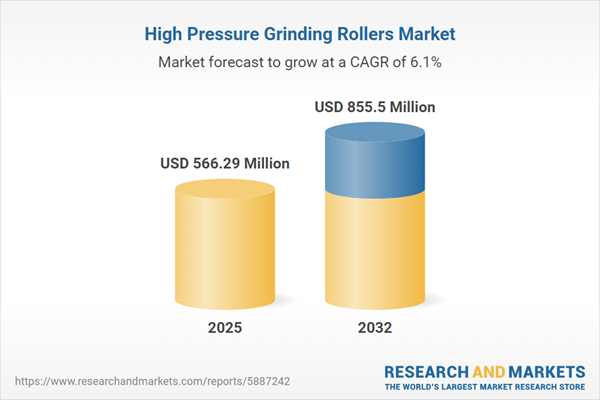Speak directly to the analyst to clarify any post sales queries you may have.
High pressure grinding rollers have become essential for industrial leaders committed to advancing operational modernization, efficiency, and sustainability in heavy industries. These systems are central to process optimization efforts, supporting business stability and compliance across a range of demanding applications.
Market Snapshot: High Pressure Grinding Rollers Market Growth and Outlook
The high pressure grinding rollers market is experiencing steady growth, reaching a value of USD 534.13 million in 2024 as organizations prioritize investments in advanced processing technologies. Industry trends show robust interest in these systems to deliver productivity improvements, control operational expenses, and meet changing regulatory expectations. The forecasted increase to USD 566.29 million in 2025 and a projected 6.06% CAGR position the market for continued upward trajectory, leading to an anticipated value of USD 855.50 million by 2032. Growth momentum is strongest in sectors such as mining, power generation, and heavy industries, where HPGR solutions address the twin objectives of workflow efficiency and sustainable operations. As enterprises adopt these systems, they solidify processing resilience and support modernization aligned with strategic, environmental, and business objectives.
Scope & Segmentation: High Pressure Grinding Rollers Industry
- Application: Integral for cement manufacturing, mineral processing, metallurgical processes, and energy generation, these rollers underpin stable and high-capacity workflows across diverse heavy-industry environments.
- Roller Configuration: Selection between single and double roll designs enables flexibility for new facilities, modular upgrades, and the effective retrofitting of legacy plants.
- Pressure Range: Solutions cover high, medium, and low-pressure variants, allowing adaptable grinding performance for a variety of feedstocks and operational scenarios.
- Roller Material: Manufactured using hardened steel or specialized ceramic coatings, rollers are engineered for maximum durability and abrasion resistance to support extended service life.
- Operation Mode: Available as stationary units for continuous output and as mobile assemblies to deliver performance benefits directly at project sites or remote installations.
- Sales Channel: Supported by direct equipment sales, spare parts and aftermarket services, and comprehensive asset management to drive system reliability and lifecycle value.
- Geographic Regions: Demand is distributed across the Americas, Europe, Middle East, Africa, and Asia-Pacific, with strong market engagement in China, India, Southeast Asia, Australia, and leading Western economies, driven by regulatory and efficiency mandates.
- Key Players: The industry landscape features established manufacturers including Metso Outotec Oyj, FLSmidth & Co. A/S, The Weir Group plc, thyssenkrupp Industrial Solutions AG, Loesche GmbH, CITIC Heavy Industries Co., Ltd., Danieli & C. Officine Meccaniche S.p.A., Hosokawa Alpine Aktiengesellschaft, Shandong Shunda Co., Ltd., and KHD Humboldt Wedag International AG.
Key Takeaways: Strategic Insights for Senior Decision-Makers
- Integrating high pressure grinding rollers leads to measurable efficiency gains and supports throughput improvements in large industrial production systems.
- Deployment of digital monitoring and automation platforms enables predictive maintenance, lowers risk of unplanned outages, and supports resilient facility operations.
- Advances in engineering and material science have extended the reliability and adaptability of grinding rollers, better equipping organizations to handle diverse and abrasive raw materials.
- Resource efficiency strategies delivered through HPGR technology support compliance with environmental standards while improving lifecycle sustainability outcomes for asset-intensive sectors.
- Aftermarket support, combined with targeted logistics, helps maintain operational continuity by mitigating the risks associated with supply chain disruptions and securing fast access to essential components.
- Adopting holistic lifecycle management plans, including refurbishment and proactive spare parts planning, enhances capital investment protection and long-term productivity.
Tariff Impact: Market Shifts in Response to Trade Changes
Recent changes to tariffs in the United States have prompted North American manufacturers to reconsider procurement strategies for high pressure grinding rollers. To address shifting trade dynamics and support cost efficiency, many companies are reinforcing domestic supplier partnerships. Emphasizing maintenance and refurbishment is another way organizations are responding to evolving regulatory landscapes, contributing to stable equipment performance and operational consistency.
Methodology & Data Sources
This market analysis draws on technical reports, current regulatory data, and interviews with engineers, procurement leaders, and supply chain professionals. Insights are driven by real-world installation feedback and the latest trends, supporting actionable guidance for decision-makers in the sector.
Why This Report Matters
- Presents validated, data-backed insights to support executive teams in supplier negotiations, risk reduction, and capital allocation across global operations.
- Offers detailed segmentation and trend tracking to inform targeted technology initiatives and enhance resilience in complex, shifting markets.
- Equips leadership with recommendations for integrating compliance, process improvement, and sustainability for more robust business performance.
Conclusion
High pressure grinding rollers play a pivotal role in advancing industrial efficiency and operational resilience. As regulations and technologies evolve, these systems remain crucial for organizations seeking reliable, compliant, and sustainable production strategies.
Additional Product Information:
- Purchase of this report includes 1 year online access with quarterly updates.
- This report can be updated on request. Please contact our Customer Experience team using the Ask a Question widget on our website.
Table of Contents
3. Executive Summary
4. Market Overview
7. Cumulative Impact of Artificial Intelligence 2025
Companies Mentioned
The companies profiled in this High Pressure Grinding Rollers market report include:- Metso Outotec Oyj
- FLSmidth & Co. A/S
- The Weir Group plc
- thyssenkrupp Industrial Solutions AG
- Loesche GmbH
- CITIC Heavy Industries Co., Ltd.
- Danieli & C. Officine Meccaniche S.p.A.
- Hosokawa Alpine Aktiengesellschaft
- Shandong Shunda Co., Ltd.
- KHD Humboldt Wedag International AG
Table Information
| Report Attribute | Details |
|---|---|
| No. of Pages | 195 |
| Published | October 2025 |
| Forecast Period | 2025 - 2032 |
| Estimated Market Value ( USD | $ 566.29 Million |
| Forecasted Market Value ( USD | $ 855.5 Million |
| Compound Annual Growth Rate | 6.0% |
| Regions Covered | Global |
| No. of Companies Mentioned | 11 |









